Earth minerals and metal ores[
Main articles: Mineral and Ore
Further information: Mining
Earth minerals and metal ores are examples of non-renewable resources. The metals themselves are present in vast amounts in Earth's crust, and their extraction by humans only occurs where they are concentrated by natural geological processes (such as heat, pressure, organic activity, weathering and other processes) enough to become economically viable to extract. These processes generally take from tens of thousands to millions of years, through plate tectonics, tectonic subsidence and crustal recycling.
The localized deposits of metal ores near the surface which can be extracted economically by humans are non-renewable in human time-frames. There are certain rare earth minerals and elements that are more scarce and exhaustible than others. These are in high demand in manufacturing, particularly for the electronics industry.
Phosphorous is an example of a non-renewable resource that may run out within this generation. Phosphorous is a crucial resource to maintain crop production, yet most phosphorous is mined from rock phosphate [1]. The demand for phosphates is predicted to increase and some believe that global phosphates could become depleted in the next 50-100 years [2]. The management of natural resources is important for this reason.To successfully manage resources mechanisms that acknowledge the dynamics of production are needed [3].

References
-
^ Cordell, Dana; Drangert, Jan-Olof; White, Stuart (2009-05).
"The story of phosphorus: Global food security and food for thought". Global Environmental Change. 19 (2): 292–305.
doi:
10.1016/j.gloenvcha.2008.10.009.
ISSN
0959-3780.
{{ cite journal}}: Check date values in:|date=( help) -
^ Smil, Vaclav (2000-11).
"PHOSPHORUS IN THEENVIRONMENT: Natural Flows and Human Interferences". Annual Review of Energy and the Environment. 25 (1): 53–88.
doi:
10.1146/annurev.energy.25.1.53.
ISSN
1056-3466.
{{ cite journal}}: Check date values in:|date=( help) -
^ Prior, T.; Giurco, D.; Mudd, G.; Mason, L.; Behrisch, J. (2012-08).
"Resource depletion, peak minerals and the implications for sustainable resource management". Global Environmental Change. 22 (3): 577–587.
doi:
10.1016/j.gloenvcha.2011.08.009.
ISSN
0959-3780.
{{ cite journal}}: Check date values in:|date=( help)
Earth minerals and metal ores[
Main articles: Mineral and Ore
Further information: Mining
Earth minerals and metal ores are examples of non-renewable resources. The metals themselves are present in vast amounts in Earth's crust, and their extraction by humans only occurs where they are concentrated by natural geological processes (such as heat, pressure, organic activity, weathering and other processes) enough to become economically viable to extract. These processes generally take from tens of thousands to millions of years, through plate tectonics, tectonic subsidence and crustal recycling.
The localized deposits of metal ores near the surface which can be extracted economically by humans are non-renewable in human time-frames. There are certain rare earth minerals and elements that are more scarce and exhaustible than others. These are in high demand in manufacturing, particularly for the electronics industry.
Phosphorous is an example of a non-renewable resource that may run out within this generation. Phosphorous is a crucial resource to maintain crop production, yet most phosphorous is mined from rock phosphate [1]. The demand for phosphates is predicted to increase and some believe that global phosphates could become depleted in the next 50-100 years [2]. The management of natural resources is important for this reason.To successfully manage resources mechanisms that acknowledge the dynamics of production are needed [3].

References
-
^ Cordell, Dana; Drangert, Jan-Olof; White, Stuart (2009-05).
"The story of phosphorus: Global food security and food for thought". Global Environmental Change. 19 (2): 292–305.
doi:
10.1016/j.gloenvcha.2008.10.009.
ISSN
0959-3780.
{{ cite journal}}: Check date values in:|date=( help) -
^ Smil, Vaclav (2000-11).
"PHOSPHORUS IN THEENVIRONMENT: Natural Flows and Human Interferences". Annual Review of Energy and the Environment. 25 (1): 53–88.
doi:
10.1146/annurev.energy.25.1.53.
ISSN
1056-3466.
{{ cite journal}}: Check date values in:|date=( help) -
^ Prior, T.; Giurco, D.; Mudd, G.; Mason, L.; Behrisch, J. (2012-08).
"Resource depletion, peak minerals and the implications for sustainable resource management". Global Environmental Change. 22 (3): 577–587.
doi:
10.1016/j.gloenvcha.2011.08.009.
ISSN
0959-3780.
{{ cite journal}}: Check date values in:|date=( help)